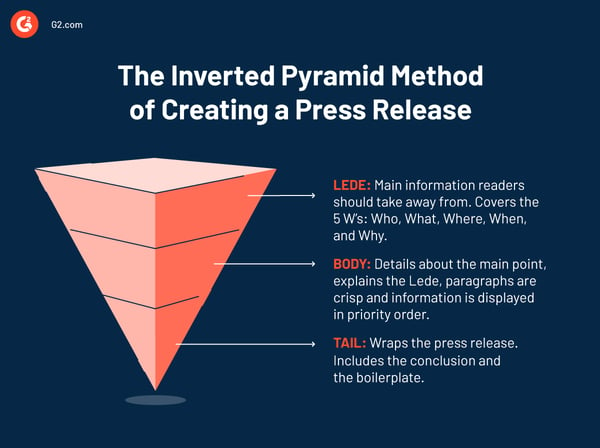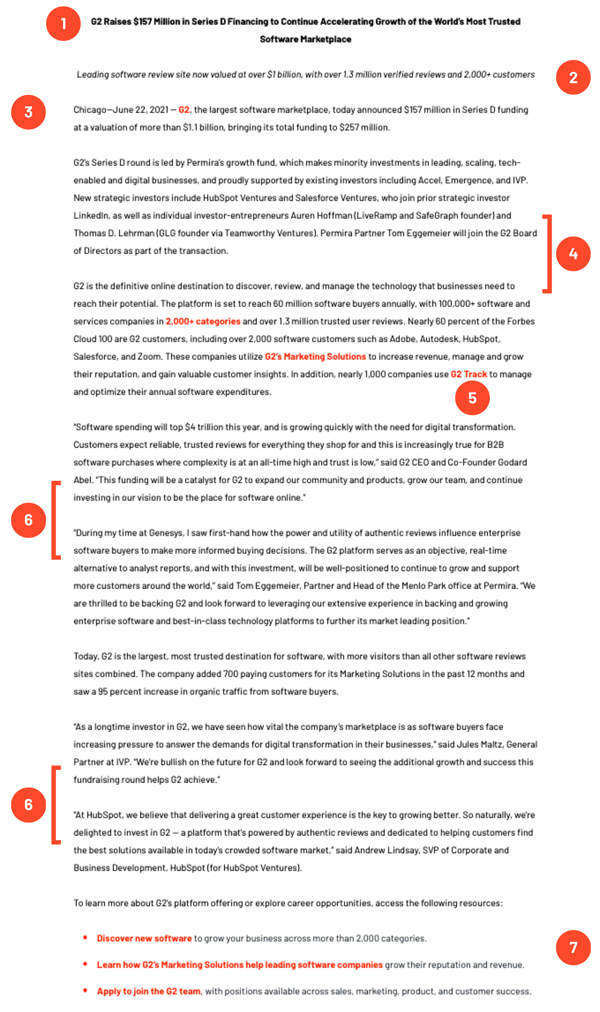October 8, 2021
 by Ninisha Pradhan / October 8, 2021
by Ninisha Pradhan / October 8, 2021

An effective press release garners the right media attention, generates widespread coverage, and impacts brand perception. So what makes a press release stand out? What is the difference between a press release that is picked up and the one ignored?
It all starts with understanding the key press release elements. Knowing what to say — and how to say it — will help you secure the attention of influential media outlets. While many press release distribution services have editorial teams to help you write press releases, creating your own press release pays off in the long run.
If you're struggling to figure out what needs to go in a press release, fret not. We'll break down the elements and have you creating the perfect news release format in no time.
Technically, a press release can be about anything a company considers “newsworthy”. That said, patterns have emerged in the most common scenarios where a press release can work well.
Here are some standard press releases that businesses use:
Typically, a press release follows this format:
Understanding the basic elements and format of press releases will take you far. Journalists are more likely to reward you with media coverage when the content you submit is structured to grab their attention.
While not every press release needs to follow this format, some crucial elements shouldn’t be forgotten when crafting your press statement.
Speaking of elements, let’s look at each element that makes up a press release.
A good press release follows an inverted pyramid format of listing information. An inverted pyramid is wide at the top and tapers at the bottom.

Information in a media release should also follow a similar pattern with the most important information at the top and other data that doesn’t necessarily add to the main point but can still be mentioned at the bottom.
Start a press release with an attention-grabbing headline in bold font. Begin the body copy with the date and city that the release is from. Your lead sentence should be a concise summary of the release’s subject.
The rest of the body tells all the important details of your story: who, what, when, where, why, and how. Put the most important information first, followed by more general information, and don't forget to include your contact information at the end.
Let’s look at a sample press release to understand it better. Here’s a press release example announcing G2 becoming a startup unicorn after raising Series D funding. This sample press release uses seven key elements.

Source: G2
Think of your title as a headline in a major newspaper. The idea is to communicate the main point of your news release and intrigue the reader enough to want to know more.
There's an art in writing great press release headlines, mastered only after enough practice. When in doubt, brainstorm several options to choose from and ask your team which is the most compelling.
For the ideal headline, short and sweet is the way to go. Your title shouldn't be much longer than a tweet. A good ballpark figure for any title is 170 characters or less.
Here are a few examples of headlines you can use for inspiration:
Think of the subheading as your title’s more interesting brother. It expresses a similar but slightly more in-depth message.
This isn't the time to reveal every last detail. Your goal is to add a bit more context and pique curiosity leading to the heart of the release — 350 characters should be more than enough.
A great title gets people to read the subheading, but a great subheading gets them to the body copy: the bulk of your press release.
Your subheading should inform and intrigue, but it most likely won’t be the deciding factor —whether or not the media covers your release. That’s what the body paragraphs are for.
Next up is your dateline, which covers two of the “five W’s” of journalism: when and where your newsworthy event is happening.
The dateline is the starting point of your first body paragraph. Dates and locations should be written in bold, with the location spelled out in all capital letters.
The Associated Press (AP) style guide is preferred by news outlets, so its rules apply here. Watch out for locations in particular. Some of the largest cities are standalone, so you don't need to specify a state after. Think CHICAGO or SAN FRANCISCO. Others require a state abbreviation, such as SACRAMENTO, Calif. or MEMPHIS, Tenn.
Your body paragraphs are the bulk of your media release, especially when you go into the details, such as your new executive hire’s professional background, the new features your latest product offers, and more.
Remember the five Ws from journalism: who, what, when, where, and why. The best press releases include all five, some with plenty of time devoted to the why. It’s the “why” that will get the media excited and increase your chances of coverage.
Your press release should have a strong lead explaining your newsworthy content in one sentence. Then elaborate on the main point in the first paragraph and include the following details:
Add information about what this news could mean for the organization's customers or investors. Remember, press releases should be short paragraphs not longer than three to four lines.
At the tail end of the press release, start by listing details that weren't included initially but seem important. Include background information about the company, their journey, and any supporting data.
All paragraphs in the press release should contain information in descending order of priority, with the most important piece of news at the beginning and the less important one toward the end. Don’t forget that press releases will be published online. Therefore, it’s good to adopt search engine optimization (SEO) best practices when creating a release.
You can incorporate images, quotes, and hyperlinks into your body paragraphs to make them more compelling.
While media coverage is important, the ultimate goal of your release is to drive brand awareness. Ideally, your press release is just the starting point for a lasting relationship. By including opportunities for interaction, you’re taking an extra step to ensure you won’t be forgotten.
Think of hyperlinks as a way to continue the relationship. By linking back to relevant pages on your website, your reader can build that relationship with a click of the mouse. It also gives media outlets easy avenues for more information and research.
Just make sure you play by the rules and don’t include more links than the newswires allow. Don't add links just to add links — point them to useful pages relevant to the story and give them supplemental information.
All elements have so far been objective. Like any great news story, press releases focus on the facts. It's who, what, when, and so on — pretty formulaic.
Quotes are the one area of your press releases where you can add some emotional appeal. They're your opportunity to put the facts in a context that’ll get readers excited.
There's no one better than the people who have worked tirelessly preparing your latest product launch, partnership deal, or charitable initiative when it comes to adding quotes. Including a short statement from a key person will help convey your excitement.
Include quotes from relevant stakeholders and industry experts — influencers and big names whose opinions would interest people. You should clearly mention the person's name, current designation, and company before beginning their quote. "Don't forget to add quotation marks to mark the beginning and the end of the quote."
Here are a few examples of quotes used in the sample press release above:
Also known as an “about us” section or “corporate summary,” the boilerplate is where you offer a high-level background on your company. In about 100 words or fewer, you could include:
Unlike other elements in your press release, you only have to write your boilerplate once. You can reuse it in every release to remain consistent with your messaging. However, regularly update numbers, like revenue and employee count, to stay up to date.
Besides the elements we've covered so far, there are a few others that should be included in a press release before it is sent out to news outlets, including:
Images break up walls of text, add visual flair, and generally make your release a bit more interesting. We all know the cliche “a picture’s worth a thousand words?” While that may not be entirely true, an image allows you to elaborate on your story uniquely.
Most organizations understand that images are powerful and decide to include them in their press releases. Unfortunately, too many forget that it has to be relevant to be powerful.
Let’s be honest — nobody wants a press release with a stock image. First and foremost, can you say ‘boring’? But it could even backfire if you're dealing with media outlets that receive the release after it’s published. Using a stock image almost ensures your press release will blend in with the rest.
Relevant images, however, will catch the eye and amplify the message you're conveying. For example, let’s say your rebranded logo is ready, or you have a great headshot of your new executive hire. If so, don’t forget to include the visual.
Finally, if your press release is distributed online, tagging images with proper keywords will increase your visibility. Someone googling “new Chicago apartments,” for instance, might land on the image of your groundbreaking development next to Wrigley Field.
Including contact information seems like a no-brainer. That said, it can be a deal-breaker if forgotten. If a reporter is interested in your story and wants to follow up but can't find a way to reach out to you, they'll move on to the next press release in the pile.
It’s crucial to add a media contact (PR professionals, media coordinators, or communications executives) as the first point of contact for journalists for more information. Include the following to make the most of every opportunity:
Make sure you receive every message by keeping your phone number and email address updated. As for who to include, it depends. Some companies have a dedicated media liaison, while some prefer to change it up based on the nature of the release.
The first element (and arguably, one of the most important) of your press release is the release date. This gives media outlets your timeline — basically when you plan to make the information public.
Press releases focus on newsworthy items, so timing is everything. Some release dates indicate “for immediate release,” signaling to media outlets that you're ready to publicize the information right away.
But what about every PR professional’s nightmare? Secretly planning a new product launch, only to have an eager journalist spill the beans a bit too early. To prevent this, you can adjust your release date to “embargoed until [date].” This prohibits media outlets from sharing your press release until the date you specify.
Did you know? A media embargo is issued when a company (the news source) distributes newsworthy information to media publications before it is released to the general public. The embargo is a requirement from the company that prohibits the outlets from publishing the news until a certain date or set condition is met.
Getting your press releases prepared early, and embargoing them until a later date, makes it easy to coordinate the big reveal. It also gives media outlets time to prepare in-depth coverage or seek more information instead of scrambling.
Whether to release now or embargo until later depends on the respective situation. There probably isn't a good reason to delay news about your latest charity initiative. On the other hand, keeping your new CMO hire under wraps until the contract is signed makes a lot of sense.
Transitioning pages within a press release — or ending them — is often confusing. It's easy to think that a press release has ended when there's more information. Or someone assumes they’re missing something even though the release has ended.
Over time, media outlets have developed a standardized format to avoid confusion. It's simple. If your press release continues on a subsequent page, end the current page with the “more” command (displays one screen at a time when the text file is large).
However, if your press release is finished, indicate the end of the document with three hash symbols (###).
The next step in learning to write a press release is understanding the press release format.
If your press release is in a format a journalist is familiar with, your odds of getting it published are higher.
Important: Before you write a press release, you must do something newsworthy. In other words, have news which journalists actually want to cover! Your hook for the story or the finding that you’re pitching must be based on a trending topic that journalists are currently covering.
Now that you have learned the basics of a press release and what goes in it, it’s time for you to start building public relations. Here’s a free press release template to get you started.
.png?width=600&name=free%20press%20release%20template%20(2).png)
The content in your press release can be structured differently depending on the type of press release and the event surrounding the news. It’s impractical to have press release templates ready for any possible situation. However, it's a good practice to create generic templates for critical occasions.
While the press release format varies based on the occasion, a general rule applies to all: prioritize key messages and don’t let them get lost in a flurry of words. By keeping the press release format as an integral part of your PR plan, you can avoid last-minute hiccups that tend to crop up during a PR campaign.
Formats aren’t always binding. Depending on the channel you wish to target and the content itself, the elements you include in your press release will vary from story to story. What’s more important is to present your message and information in the best way possible so that readers and journalists can digest the content and retain it effectively.
Now that you know the format, it’s time to learn how to write a press release.
Ninisha is a former Content Marketing Specialist at G2. She graduated from R.V College of Engineering, Bangalore, and holds a Bachelor's degree in Engineering. Before G2, Ninisha worked at a FinTech company as an Associate Marketing Manager, where she led Content and Social Media Marketing, and Analyst Relations. When she's not reading up on Marketing, she's busy creating music, videos, and a bunch of sweet treats.
Ancient Greeks had the God of Messengers, but modern-day companies have the King of...
 by Ninisha Pradhan
by Ninisha Pradhan
Social media is essential for building your business online.
 by Yash Chawlani
by Yash Chawlani
Do you find yourself repeating the same tasks with every project you start?
 by Max Benz
by Max Benz
Ancient Greeks had the God of Messengers, but modern-day companies have the King of...
 by Ninisha Pradhan
by Ninisha Pradhan
Social media is essential for building your business online.
 by Yash Chawlani
by Yash Chawlani


